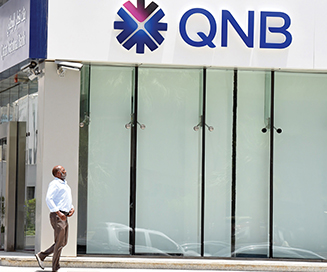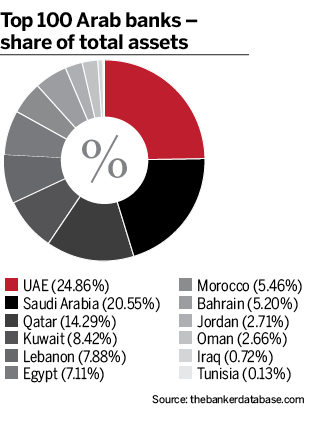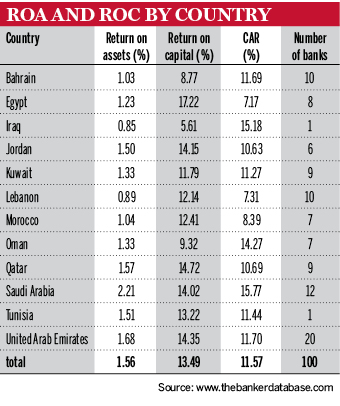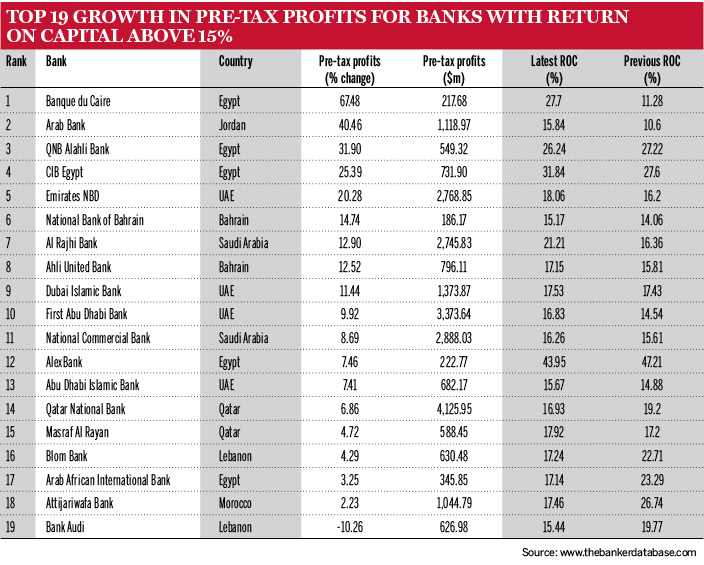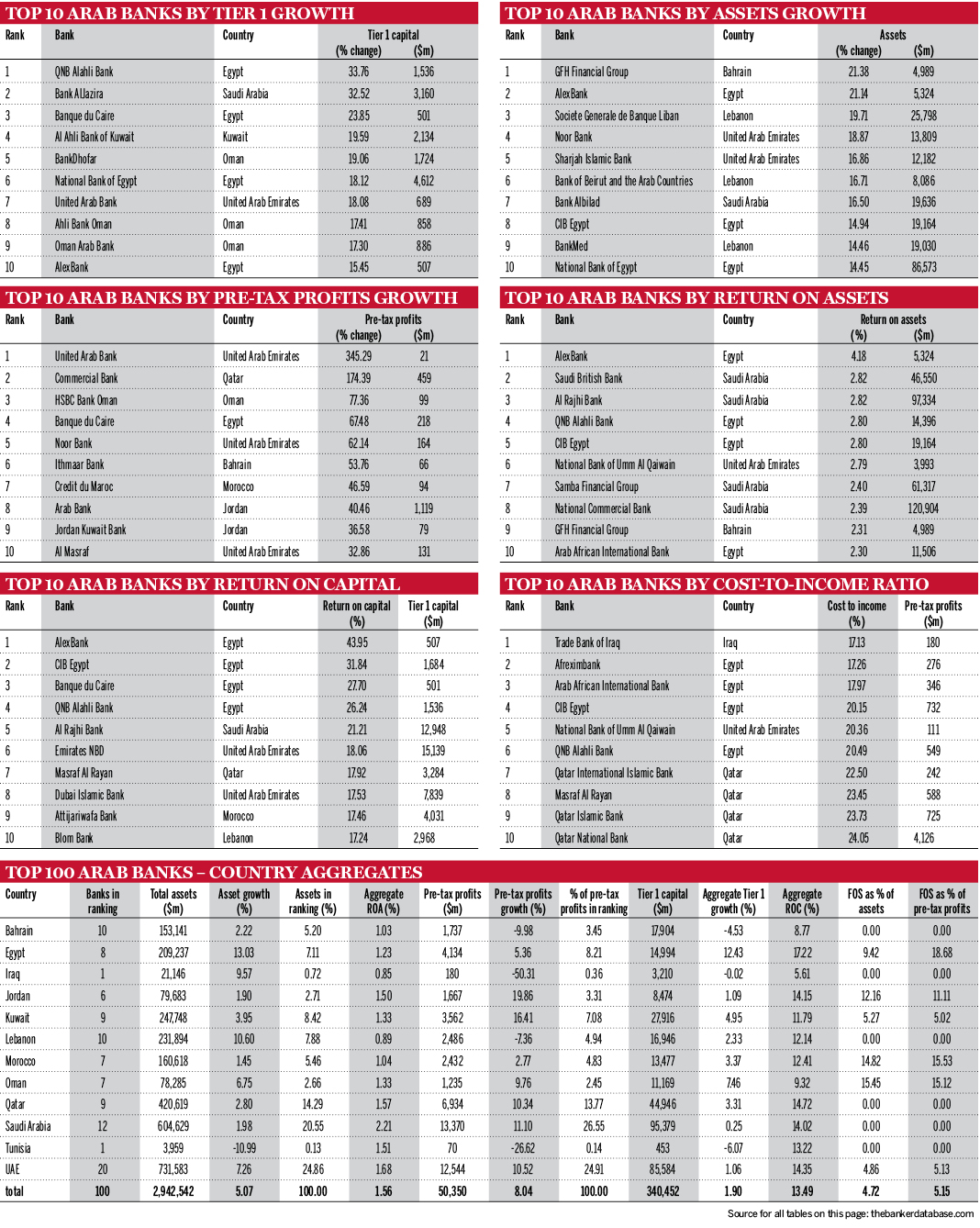The Banker's Top 100 Arab Banks ranking 2019: QNB back on top
Gulf banks dominate The Banker's Top 100 Arab Banks ranking on the back of a wave of mergers, with north African lenders faring less well, as John Everington reports.
The Banker’s Top 100 Arab Banks rankings for 2019 highlight a return to prominence for some of the region’s biggest names and markets, reclaiming the limelight from their smaller, faster growing peers.
This trend is most visible in the Gulf, with the established markets of Qatar and Saudi Arabia the big winners in this year’s scores. Qatar National Bank (QNB) returns to the top of the overall rankings just one year after being displaced by First Abu Dhabi Bank (FAB) of the United Arab Emirates, in line with Qatar’s recovery from the impact of an economic boycott by some of its Gulf neighbours. Lenders in Saudi Arabia, meanwhile, made some of the ranking's biggest profitability gains, even as back tax payments knocked their Tier 1 capital.
With the notable exception of Egyptian lenders, the 2019 rankings reflect how many of the previous star performers from north Africa and the Levant have come back down to earth with a bump, as economic and political uncertainties impact banks’ profitability metrics. Such metrics continue to fall across the Middle East and north Africa as a whole, even as they remain generally favourable compared with their peers elsewhere in the world.
QNB reclaims crown
QNB’s Tier 1 capital rose 12.04% to $22.5bn in the 2019 rankings, pushing the bank back up into top position after being narrowly displaced by FAB in the 2018 Top 100 Arab Banks ranking. The improvement in QNB’s fortunes coincided with a similar bounce-back by Qatar’s economy as a whole in 2018, as the impact of the political and economic isolation imposed in June 2017 by Saudi Arabia and the UAE, among others, continued to fade.
Qatar’s risk profile has subsequently improved – Moody’s upgraded its outlook for the banking sector to 'stable' from 'negative' in October 2018 – while asset quality and profitability has been solid among the country’s lenders.
In a year when the constituents of the top 10 remain unchanged, the other noticeable trend is the impact of the Saudi government’s demand for additional zakat (religious tax) payments on the capital positions of the country’s banks. National Commercial Bank (NCB) was the exception to the rule, its Tier 1 capital rising 4.4% to $17.8bn in 2018, enabling it to retain its position as the Arab world’s third largest lender. But Al Rajhi Bank – which agreed in December 2018 to a $1.4bn zakat settlement – saw its Tier 1 capital fall 12.9% to $12.9bn in 2018. This has led to the lender dropping to fifth position in the 2019 rankings from fourth previously, swapping places with Dubai’s Emirates NBD.
Fellow Saudi lenders Samba and Riyad Bank suffered a similar fate in 2018, their Tier 1 capital bases declining by 0.8% and 4.8%, respectively, though the banks have maintained their positions of sixth and seventh in the 2019 rankings.
After entering the top 10 of the Top 100 Arab Banks ranking for the first time in 2018, National Bank of Kuwait has jumped another two places, with its 4.6% rise in Tier 1 capital lifting it to eighth place in the 2019 rankings.
M&A impact
The top 10 is rounded off by Saudi British Bank (SABB), whose Tier 1 capital was virtually unchanged at $8.9bn in 2018, and the UAE’s ADCB, which posted a 0.8% rise. Both lenders are set to see their positions improve in the 2020 rankings, benefiting from the continuing wave of mergers among Gulf lenders, a trend that started with the creation of FAB from the coming together of Abu Dhabi’s First Gulf Bank and National Bank of Abu Dhabi in April 2017.
SABB’s merger with fellow Saudi lender Alawwal was finalised in June 2019, creating the third largest lender by assets in the country. A month earlier, ADCB completed a merger with UNB and Al Hilal Bank, creating the UAE’s third largest bank.
Return on capital hit
QNB’s strengthening capital may have propelled it back to the top of the overall rankings for the Arab world, but its return to the top came at the cost of its return on capital (ROC). The bank’s 5% rise in net profit – compared with a 12% rise in Tier 1 capital – saw its ROC drop for the fifth consecutive year, from 19.2% in 2017 to 16.93% in 2018.
The decline means that QNB falls from first to third place in the ROC rankings for the top six Arab banks. The other five lenders all see their ROC positions improve in the 2019 rankings, however, underlining the stability of the sector. Al Rajhi Bank sees the biggest improvement, thanks largely to the dramatic fall in its Tier 1 capital position. The Islamic bank's ROC jumped from 16.36% in 2017 to 21.21% in 2018, propelling it to the top of the big six.
Regional profitability slips
Outside of the big four markets of the UAE, Saudi Arabia, Qatar and Kuwait – which account for more than two-thirds of the Middle East and north Africa’s asset base – Arab lenders on aggregate remain in good health compared with much of the rest of the world. After slowing in 2017, asset growth across the Arab world grew by 5.07% in 2018 – a rate second only to that of Central and South America – with total assets hitting $2943bn, led by strong growth in Egypt (13.03%) and Lebanon (10.6%).
Partly as a result, return on assets (ROA) for the region dipped to 1.56%, with ROC falling to 13.49%. Both figures remain higher than global aggregate figures of 0.73% and 10.87%, however. Meanwhile, Arab banks posted an aggregate 1.9% growth in Tier 1 capital in 2018, compared with a global aggregate growth of just 1%.
Improvements in profitability metrics for the year were confined to the big four, with Saudi banks enjoys the biggest rises, as profits growth outstripped both a growth in assets and Tier 1 capital. Saudi lenders saw their aggregate ROA rise to a region-leading 2.21% in 2018 (the only score of more than 2% across the region) compared with 2.03% in 2017. ROC, meanwhile, rose to 14.02% from 12.65%.
Qatari banks, which saw their profitability slip lower in 2017, enjoyed a recovery during the most recent review period. ROA posted a modest increase, rising from 1.54% to 1.57%, while ROC rose from 14.39% to 14.72%.
North Africa feels squeeze
While all Arab countries outside the big four suffered declines in profitability in 2018, nowhere was the impact felt more than in north Africa, which suffered a severe slowdown after a stellar year in 2017. Egypt remains the market leader for the Arab world in terms of ROC with 17.22%, but this is a significant drop on the previous figure of 28.7%.
Tunisia, one of the star performers in the 2018 rankings, has suffered in 2019 as assets, profits and Tier 1 capital all declined. ROA fell back from 2.15% to 1.51%, with ROC declining from 19.87% to 13.22%. Moody’s revised its outlook to 'negative' for the country’s banking sector in October 2018, noting the government’s limited capacity to prop up the sector amid a weakening foreign exchange position.
Although Moroccan lenders continued to grow their assets, profits and Tier 1 capital in 2018, ROA and ROC fell to 1.04% and 12.41%, respectively, from 18.15% and 1.49% in last year’s rankings.
Despite an impressive growth in assets, Lebanese banks suffered an aggregate 7.36% decline in profits in 2018, pulling down the country’s ratios. Aggregate ROA fell to 0.89% from 1.29%, while ROC dropped from 16.36% to 12.14%. Lebanese lenders are facing a deadly cocktail of low growth, high deficits and debt, and rising risk premiums, and had a tough year in 2018. Just two lenders qualified for the list of the top 19 Arab banks by pre-tax profit growth with an ROC above 15% for 2019, compared with the four that made the cut in the previous rankings.
Blom Bank, which registered a 4.29% rise in pre-tax profits and a ROC of 17.24% in 2018, stands at 16th overall, up from 20th in the 2018 rankings. Bank Audi, Lebanon’s largest bank by Tier 1 capital, is 19th, down from 17th in last year's ranking, after its profits fell 10.26% during 2018.
Despite falls in ROA and ROC, Egyptian banks are regional stars when it comes to profit growth, fielding five lenders in the top 19 table – more than any other country. Banque du Caire tops the table this year, with a 67.48% growth in pre-tax profits, and its ROC surging to 27.7%, up from 11.28% previously. QNB Alahli, which topped the table last year, comes third in the 2019 rankings with a profit rise of 31.9%. CIB Egypt follows in fourth position, with a pre-tax profit growth of 25.39%.
Jordan’s Arab Bank is second in the overall profits rankings, rising from 16th position in 2018. The bank posted an impressive 40.46% rise in profits for the 2018 review period, with its ROC rising from 10.6% to 15.8%.
The impressive profit growth by Egyptian banks was not replicated by other north African lenders in 2018. In contrast to the 2018 rankings, which contained three Moroccan banks and one from Tunisia, just one bank from francophone north Africa, Attijariwafa Bank of Morocco, makes the cut, as lower profit growth saw returns on capital decline. Moroccan lenders posted a mere 2.77% increase in aggregate pre-tax profits for 2018, while that figure fell by a dramatic 26.62% for Tunisia.
Good year for Gulf profits
Gulf lenders meanwhile had a stellar year in 2018, with 10 banks from the region making the top 19 compared with seven in 2018’s rankings. Emirates NBD leads the way among Gulf banks for the second year in a row, its 20.28% rise in pre-tax profits putting it fifth position, up from seventh last year. Fellow Emirati banks Dubai Islamic Bank and FAB are new entrants to the top 19, with profit rises of 11.44% and 9.92%, respectively. National Bank of Bahrain is the other new entrant from the Gulf, its 14.74% rise in profits putting it in sixth place overall.
In contrast with the 2018 rankings, there is little crossover in the 2019 rankings between the top 19 by growth in pre-tax profits with an ROC of more than 15%, and the top 10 Arab lenders by total asset growth, highlighting the asymmetry between expansion and profitability in most markets in the region, with the notable exception of Egypt. While four lenders made both lists in 2018’s rankings, this year only Egyptian lenders AlexBank and CIB Egypt feature in the table of the fastest asset growth, in second and eighth places, respectively.
Egypt’s attractions are confirmed by the appearance of four lenders in the top 10 Arab banks by ROA, up from three in 2018’s rankings. AlexBank tops the pile with an ROA of 4.18%, with QNB Alahli Bank, CIB Egypt (both 2.8%) and Arab African International Bank (2.3%) in fourth, fifth and 10th place, respectively.
Gulf lenders make up the remainder of the top 10, including four Saudi lenders, led by SABB and Al Rajhi. Though this is a slight reduction on the 2018 rankings, when five Saudi lenders featured, the fact that all four lenders feature in the top 10 of the overall Arab banks ranking highlights the vibrancy of the country’s banking sector, even as the country’s economy grapples with significant economic reforms in a bid to lessen its reliance on oil revenues.
Egypt impresses for ROC
A similar picture emerges in terms of ROC, with Egyptian lenders AlexBank, CIB Egypt, Banque du Caire and QNB Alahli Bank occupying all four top spots. Saudi Arabia’s Al Rajhi is the best performer of four Gulf lenders in the list, with an ROC of 21.21%, while Morocco’s Attijariwafa and Blom Bank of Lebanon occupy ninth and 10th slots with ROCs of 17.46% and 17.24%, respectively.
Banks from across the Middle East and north Africa continue to work hard to control costs amid often challenging operating conditions. This strategy is found in large and small banks, even in markets where growth may be justifiably seen as a greater short-term priority.
Trade Bank of Iraq, the country’s sole representative in the Top 100 Arab Banks ranking, leads the table for cost-to-income ratio (CIR), with its pre-tax profit of $180m being achieved with a CIR of 17.13%. Once again, however, Egyptian lenders dominate the top 10 CIR rankings; Afreximbank is the pick of this pack, making second place with a CIR of 17.26%. Four Qatari lenders occupy positions six to 10 in the rankings, led by Qatar International Islamic Bank with a CIR of 22.5%.
A shifting landscape
The Banker’s 2019 Top 100 Arab Banks ranking showcases a regional banking sector that continues to surprise, reflecting a constantly shifting economic landscape. In the affluent markets of the Gulf, Qatar’s re-emergence following the shock of its isolation by some of its neighbours is exemplified by QNB’s return to the top of the overall rankings after an absence of just one year, together with impressive ROC growth across all its lenders.
While suffering a knock to their capital positions and a challenging economic environment, Saudi lenders also remain in rude health, boasting impressive growth in both ROA and ROC. With further consolidation on the horizon, in the form of SABB’s merger with Alawwal and a mooted acquisition of Riyad Bank by NCB, Saudi’s main lenders look as strong as ever.
Arab banks’ impressive asset growth highlights the enormous potential that exists in the region, particularly within north Africa. Egyptian lenders have continued to take full advantage of such potential, aided by economic liberalisation and booming growth. Yet the slowdown in fortune experienced by former star performers in Morocco, Tunisia and Lebanon are a reminder of how precarious such growth can be.
As Arab economies wrestle with the challenges and opportunities of growing populations, economic reform and the increasingly unpredictable nature of oil prices and global trade, these remain exciting, if testing, times for Arab lenders, with further consolidation and transformation an inevitable prospect.



